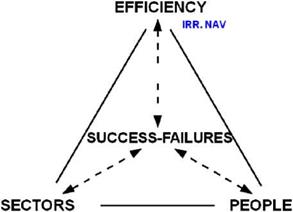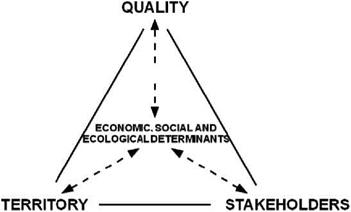At this moment in time, the processes of human society development are dominated by the sectorial approach. Each sector pursues optimization according to their own requirements, such as: economic, urbanistic; agricultural, rural, real state, forestry, mining sectors. This approach triggers territorial degradation tendencies as is doesn’t considerer territorial integrity. It is a merological approach, reducing the problem to specific problems and interests.
On the other hand, the territorial approach centers the main objective on the landscape planning units and its surroundings, focusing on the integral system development. It is based on the holistic system paradigm, emphasizing a transdisciplinary approach as a key epistemological attribute for human development processes.
The XX century traditional paradigm focuses on three main interacting components: sectors, people and economic efficiency (Figure 4). With this approach, activities and development processes are evaluated as successes or failures, considering mainly the economic parameters, such as IRR (internal return rate) and NAV (real net value) [53].
In the XXI century a new paradigm emerges. The model integrates three dimensions: territory in instead of sectors; stakeholders instead of people; global quality instead of economic efficiency (Figure 4). The global indicator parameter for the sustainable cultural landscape construction and evaluation is related to each specific condition, and is a function of the following variables: ecological, social and economic. It is a determinant based on the interaction of three main axes: economic productivity, social equity and ecological sustainability [66, 69]. This approach and paradigm focus on the sustainable development and life’s quality.
TRADITIONAL PARADIGM OF THE XX CENTURY:
|
|
NEW PARADIGM OF THE XXI CENTURY:
|
Fig. 4. Evolution of the development paradigm. The new paradigm focuses on cultural landscape, integrating sustainable development and life’s quality [53]. |
1.4 Territorial arrangement and cultural landscape design
Territorial arrangement and planning is not only a technological, ecological and political subject, there are also related with the spirits of age and place (Zeitgeist and Volksgeist). The Territorial arrangements of a country and places are always related with culture [15].
The European Cart of Territory Arragement, emphasized regional territorial balance. They pursued a territorial arrangement with the best distribution of spatial and human activities, to achieve the best combination, as a function of societies’ requirements given its culture, ecological limitations and potential, as well as, life quality optimization and sustainable development. The multiple use principle is a main argument referring to the purpose and management of territorial resources, in order to provide a better use for human requirements without causing ecosystem degradation, as well as, setting up areas for human life and integral development. Thus, multiple use of the territory focuses on different objectives from many sectors and subjects [70].
Watershed is the basic unit for territorial arrangement and where biocenosis (phytocenosis and zoocenosis) interact with the ecotop. Social, economic, institutional and cultural dimensions of the stakeholders administration, resource management and arrangement at the watershed level, are related with a, p, у diversity.
The design of the cultural landscape is an essential element and operator to reach the goal of balance, the stakeholders need in the landscape context [71]. Presently it is necessary in order to increase territorial services and sustainability, not only to preserve but also to design and construct [13], with an integrative, dynamic, intentional and collective approach. The fundamental dimensions in the cultural landscape design are: ecological, anthropic functionality, life and leisure, and aesthetics.
The ecological dimension refers to system sustainability as a result of cultural landscape nature conservation, ecological connectivity and ecodiversity. It optimizes the positive and negative ecosystem effects, designs the structural cycles (recycling) and ecosystem efficiency, in addition to stability (energy, matter and information). Another key concept is technological receptivity, defined as the amount of technology that could be applied in each particular site to produce a desired sustainable output. Technological receptivity allowed discriminating differences to select the right operator [14].
The functionality dimension is reared towards human actions aspiring to accomplish the activities associated with stakeholders’ objectives. The aesthetic dimension deals with symmetry, beauty and landscape perception, which deals with elements such as forms, colors, textures, borders, observations points, etc. Life and leisure dimension are related with resting places for the social actors amusement. Leisure is something highly valuated associated with the creative potential of people and human development [72]. All of this is related with the concept of biophylia, which can be defined as the inherent tendency of humankind to get closer to different kinds of life and natural processes, desirable for a better life quality in step with human evolution during a long period of time.
The landscape design methodology is presented in Figure 5. The first stage is the polithemathic analysis of the landscape’s limits, including: zoning, technology, hydrology and the natural matrix in a topological arrangement. The second stage established the threshold of the landscape: functionality, aesthetics, ecology, as well as life and leisure. Then, in the third stage, the territorial components: saltus, ager and polis, and their relative proportions in cultural landscape types: wildland, rural and urban. The last part is directly related with the construction of cultural landscapes by the action of the stakeholders and stockholders.
 |
The design and construction of sustainable cultural landscapes include:
– Diversity. Refers in a broad sense to biodiversity (а, в and y), ecodiversity (niches and habitats) and territorial diversity, the last one related with territorial multiple use.
– Connectivity. Refers to the generation of ecosystemic and territorial networks, including: technological (resource management styles), social, cultural and institutional dimensions. It is a complement of the ecosystem interaction network considering the stakeholder and technology.
– Coupling. The ecological connections aren’t enough, they also require energy, matter and information exchange by coupling between system’s components. System functionality requires the complementation and integration of their components.
– Location. Technological receptivity and ecosystem resilience is a function of the location of the watershed and biocenosis type [70].
– Recurrence. Design and management of ecological and territorial systems should not be lineal but recurrent. This is equivalent to recycling in natural ecosystems. The recurrent input management is related to achieve adaptation [73]. Agriculture ecosystem design and management is related with connectivity and grater autonomy of agroecosystems.





